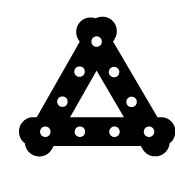Triangle edges
Problem

How many triangles can you make using sticks that are 3cm, 4cm and 5cm long?
Each side can only use one stick but a triangle can use more than one stick of the same length.
You may like to use this interactivity to try out your ideas.
You could use sticks that have 4 holes, 5 holes and 6 holes to represent the 3cm, 4cm and 5cm sticks.
Getting Started
Can you make a triangle which has all sides the same length? Are there any other triangles with equal length sides?
Student Solutions
Lucy from Avoca Beach, Australia wrote to say:
There are ten different triangles.
Ruth from Swanbourne House School gave us a little more detail about the triangles:
Thank you to both of you.
Teachers' Resources
Why do this problem?
This problem lends itself very well to practical exploration using sticks or construction rods. Having this "hands-on" experience will help children to realise the need to be systematic and develop their own recording system. The task offers children the chance to explore all the ways in which they can choose three sticks to make a triangle.
Possible approach
Once they have made some, bring the class together to share their results, perhaps using the interactivity so that it is easy for everyone to see. Encourage the children to use descriptive language that is accurate mathematically to tell you about the triangles they have made.
Key questions
How do you know they are different?
Have you found them all?
Are there any that are similar in any way? How?
Possible extension
How many extra possiblilities would this create?
This approach lays the foundations for systematic working that is so important in mathematics. You could also introduce the idea of perimeter - the distance around the edge of the shape - using questions such as:
How could you make the triangle with the smallest possible distance around the outside (smallest perimeter)?
How about the triangle with the next smallest perimeter?
Possible support
For children who are finding this difficult start by focusing on making specific triangles such as one with three sides of length three. Then change one side. Stay with using practical apparatus for longer and help to scaffold their thinking systmatically. Encourage them to use descriptive language and to look for similarities and differences between triangles. Ask them what is the same and what is different about two triangles.
